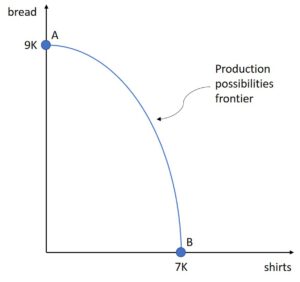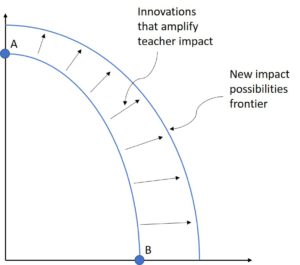This is the first post in a three-part series on strategies for expanding the impact of schools and teachers. The other posts in the series are available at the following links: part 2, part 3.
Last month, a new study by the RAND Corporation made headlines for its lackluster findings. Following a multi-year, multi-million-dollar initiative by the Gates Foundation to boost school performance through better teacher evaluation systems, RAND’s researchers found that the initiative failed to produce significant gains in student outcomes. When a promising education reform like this one misses the mark, where should education leaders turn next? If we step back and look at the big picture, what options do we really have for dramatically improving schools?
There’s an idea from Economics that I find quite elucidating when considering this question. It’s called the “production possibilities frontier.” Here’s a simplified example to illustrate the concept: Suppose a hypothetical non-profit called Basic Aid makes two goods—bread and shirts—for people in need. If the non-profit has its employees spend all their time producing bread, it can churn out nine thousand loaves a month. Alternatively, Basic Aid could schedule its employees to spend all their time making shirts and produce seven thousand shirts a month. Most months, however, the non-profit has its employees split their time between these two forms of production.
The graph below represents Basic Aid’s production options. At point A, Basic Aid only makes bread. At point B it only makes shirts. Connecting those two points is a curve that shows all the ways Basic Aid could maximize its production of bread and shirts given its available workforce. This means Basic Aid can make tradeoffs to produce any combination of bread or shirts that lies on or below the curve. But it is impossible for Basic Aid to produce combinations of bread and shirts that are beyond the blue curve. Put simply, the curve represents Basic Aid’s production possibilities frontier.
Education’s impact possibilities frontier
Now consider how this concept relates to schools. Just like the employees at Basic Aid, a school’s teachers have only so many hours in a day to dedicate to the learning and wellbeing of their students. Like Basic Aid’s employees who work on making either bread or shirts, a school’s teachers have a long list of “productive” activities they might work on during a given day—including teaching, preparing lessons, grading students’ work, tutoring students after school, attending IEP meetings, and organizing the occasional fieldtrip. In a given week, there is only so much time to allocate across these activities, which means every activity requires making tradeoffs. If a teacher spends all her time after school grading quizzes, she won’t have time to check in with students’ parents over the phone; and if she spends all her prep period tutoring, she may have to take some shortcuts in her lesson planning. In other words, teachers also have a production possibilities frontier—or perhaps more aptly named, an impact possibilities frontier—defined by the hours of their workday. As much as we like to idealize the heroic teachers that seem to do it all, all teachers face practical limits. They simply do not have the capacity to do everything for their students that we might want them to do.
Expanding schools’ impact
In the immediate term, an organization’s production possibilities frontier is fixed by its available employee work hours and other resources. But in education, we can’t accept our current outcomes as fixed. With growing inequality, persistent achievement gaps, a youth mental health epidemic, and the rising demand for a highly-skilled workforce, we need our schools to do more. But how is doing more even possible without adding more hours to the day or making massive increases to states’ education spending?
The answer is not reform, it’s innovation. The only real way to expand a production possibilities frontier—whether for a school, a company, or an entire economy—is to develop new ways of working that allow us to do more with a fixed set of resources. Innovation has been the key to rising material prosperity across the world during the last two centuries, and it is the key to expanding the impact of our schools.
To be clear, innovation does not just mean new gadgets. Innovation is any new way of organizing fixed resources and staff that allows us to do more than was previously possible. It could be adaptive learning software, but it could also be a new teaching practice that improves student engagement and retention, or a new staffing arrangement that allows teachers to focus their energy and their expertise.
Innovations can come in many forms, but as education leaders consider which innovations are most likely to expand a schools’ impact possibilities frontier, they should look first to teachers. Because teachers are a school’s number one contributor to student outcomes, any innovation that leads to expanding a school’s impact is likely going to do so not by supplanting or replacing teachers, but by amplifying their impact.
In sum, all our efforts to improve education come down to expanding the impact possibilities frontiers of our schools, primarily through innovations that amplify great teaching. This concept is directly relevant to the shortcomings of the Gates Foundation’s teacher evaluation initiative. One of the main takeaways from the RAND study was that teacher evaluation reforms demanded too much time. Unless schools receive a major increase in recurring funds to pay for more staff hours, innovation is the only way to free up the staff hours needed for teacher evaluations. You can’t expand a school’s impact possibilities frontier by just expecting people to work harder. You need innovation to help them work smarter.




